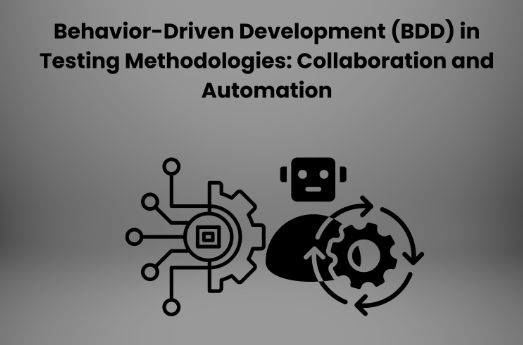Behavior-Driven Development (BDD) is an innovative way in the software development world because of the search for effective, collaborative, and Software Testing Methodologies. It’s important to acknowledge BDD’s critical role in revolutionising conventional software testing approaches as we delve deeper into its nuances. In addition to stressing cooperation among developers, testers, and business stakeholders, BDD makes use of automation to improve testing as a whole. We will examine the foundations, advantages, and application of behavior-driven development in this blog, providing insight into how it is changing the Software Testing field.
Table Of Contents
- The Intersection of BDD and Software Testing Methodologies
- The Role of BDD in Collaborative Testing
- Automation in BDD
- The Benefits of BDD in Software Testing
- Implementing BDD in Software Testing
- Conclusion
The Intersection of BDD and Software Testing Methodologies
BDD is based on a cooperative, user-centered approach to testing and software development. By acting as a link between technical and non-technical stakeholders, BDD promotes clear and efficient communication. This technique, which strives to increase the testing process’s quality, effectiveness, and agility, is in line with the wider range of software testing methodologies.
Understanding BDD Principles
User-Centric Language
BDD promotes the use of plain language to explain system behaviours so that stakeholders who are not technically inclined can understand them. Inter-team communication is facilitated by this user-centric language.
Collaboration Across Teams
Collaboration amongst developers, testers, and business stakeholders is encouraged by BDD. BDD makes ensuring that everyone has a shared grasp of the intended system functionality by including all parties in the definition and comprehension of behaviours.
Executable Specifications
BDD requirements are executable in addition to being human-readable. Teams may convert high-level requirements into automated tests thanks to this special feature, which guarantees that the programme operates as intended.
Automation Integration
Teams can automate the execution of specifications by combining BDD with automation technologies in a seamless manner. This automated feature improves the testing process’s repeatability and dependability in addition to speeding it up.
The Role of BDD in Collaborative Testing
Shared Understanding
BDD scenarios help to create a common understanding of system behaviours since they are frequently written in a language that all stakeholders can comprehend. The likelihood of misunderstandings and misalignments is decreased by this common knowledge.
Early Collaboration
By including all pertinent parties in the definition of requirements during the planning stage, BDD promotes early collaboration. This guarantees that any misunderstandings and possible problems are cleared up before implementation starts.
Quick Feedback Loop
BDD fosters constant communication, which produces a rapid feedback loop. Teams can make timely improvements since they obtain timely feedback on whether the implemented features match the specified behaviours.
Automation in BDD
Gherkin Language
The Gherkin language is used by BDD to build scenarios in an organised, legible manner. By serving as a conduit between automated testing technologies and non-technical stakeholders, this language improves maintainability and clarity.
Executable Scenarios
Gherkin-written BDD scenarios can be run. Automation tools are capable of deciphering these scenarios and carrying out the associated tests, giving quick and accurate feedback on the behaviour of the system.
Integration with Testing Frameworks
Popular testing frameworks like Cucumber and SpecFlow easily interface with BDD. These frameworks enable the automated validation of system behaviours by converting Gherkin scenarios into executable code.
The Benefits of BDD in Software Testing
Improved Collaboration
By encouraging a common knowledge of system behaviours, BDD dissolves silos between the development, testing, and business teams. This cooperative setting fosters improved communication and a shared dedication to producing software of the highest calibre.
Increased Clarity
Using a natural language format, such as Gherkin, makes requirements more understandable. Non-technical stakeholders benefit from this clarity since it makes it simple for them to comprehend and verify the intended behaviours of the system.
Early Issue Identification
BDD encourages early cooperation and ongoing input, making it possible to recognise and address possible problems in the planning and development stages. Better software is produced because of this proactive approach.
Efficient Automation
BDD uses automation to run through scenarios and confirm the actions of the system. In addition to relieving manual testers of some of their workload and expediting the testing process, automated testing guarantees the consistency and reproducibility of tests.
Agile Adaptability
BDD and Agile development methodologies work well together, enabling teams to easily adjust to changing requirements. Its emphasis on automation and teamwork makes it easier to provide software updates continuously while upholding a high standard of quality.
Implementing BDD in Software Testing
Define Clear Scenarios
Work together to define succinct and unambiguous situations using the Gherkin language to start. These scenarios must encompass the anticipated actions of the system.
Select BDD Frameworks:
Select a BDD framework that complements the tools you use for development. Popular frameworks that bridge the gap between Gherkin scenarios and executable code are Cucumber (for Java, Ruby, and other languages) and SpecFlow (for.NET).
Collaborate Continuously
Throughout the development lifecycle, keep up constant communication and coordination between developers, testers, and business stakeholders. Review and adjust scenarios frequently to make sure they are in line with changing requirements.
Automate Tests
Use automation tools to convert Gherkin situations into tests that can be run. Automated tests ought to confirm the anticipated actions, giving the development team quick feedback.
Integrate with Continuous Integration (CI)
To make sure that automated tests are run with every code change, incorporate BDD tests into your CI/CD process. A reliable and ongoing testing procedure is enhanced by this integration.
Conclusion
The software testing approaches of Behavior-Driven Development (BDD) attest to the revolutionary power of automation and cooperation. BDD transforms testing practices by promoting collaboration, utilising executable specs, and facilitating easy integration with automation technologies. BDD becomes a major actor in the software development landscape as it develops, guaranteeing not only the delivery of high-quality software but also the promotion of an agile and collaborative culture.


